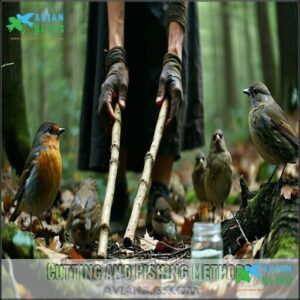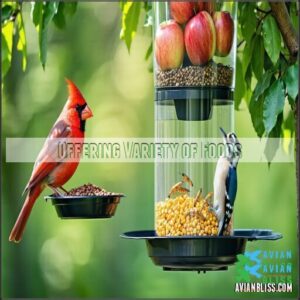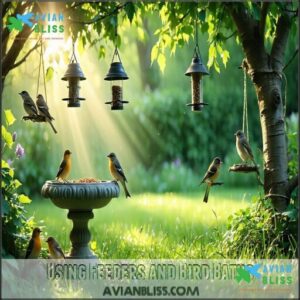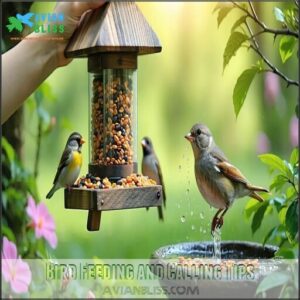This site is supported by our readers. We may earn a commission, at no cost to you, if you purchase through links.
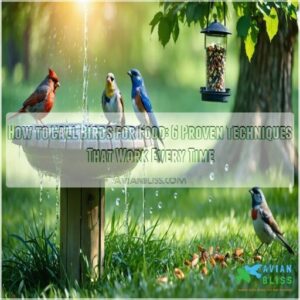
Timing matters too; early mornings are best when birds are most active and hungry.
Offer a variety of foods like seeds, suet, fruit, and mealworms to appeal to different species.
Place feeders in quiet, open areas, and add a birdbath for water—hydration is just as important as food.
Keep your setup clean and safe, as dirty feeders can discourage visitors, and with patience and consistency, you’ll create a feathered frenzy worth watching.
Ready to meet some new neighbors?
Table Of Contents
- Key Takeaways
- Calling Birds Effectively
- How to Call Birds for Food
- Bird Calling Techniques
- Attracting Birds With Food
- Bird Feeding and Calling Tips
- Frequently Asked Questions (FAQs)
- Why do birds make contact calls?
- Can you call a specific bird?
- What are bird calls?
- What are bird calling techniques?
- How do you stop a bird from Calling You?
- How do I choose a bird caller?
- How do you get birds to notice food?
- How do you make birds come to you?
- What sound attracts birds?
- How do you attract birds to food?
- Conclusion
Key Takeaways
- Mimic bird calls using pishing, whistling, or a bird call device to grab their attention and entice them to your feeding area.
- Offer a variety of food like sunflower seeds, suet, fruit, and mealworms to attract different bird species effectively.
- Create a bird-friendly setup with clean feeders, fresh water in birdbaths, and safe, visible spots near natural cover.
- Stay consistent with your timing and signals when putting out food, so birds associate your calls with mealtime over time.
Calling Birds Effectively
You’ll need to learn specific bird calls and sounds that mimic distress or feeding signals to effectively attract different species to your food offerings.
The right technique, whether it’s pishing, cutting with sticks, or using a specialized bird call device, can substantially increase your success in drawing birds to your yard or feeding station, which is a key factor in attracting different species.
Researching Bird Species
To successfully call birds for food, start by researching bird species in your area.
Learn the local bird sounds—they’re your key to attracting feathered friends and creating a lively yard full of life.
Observe their natural habitats to understand their behavior patterns. Use field guides and birding apps to identify common species and their specific diets.
Join local birding communities for support and shared knowledge. Focus on learning the unique bird calls each species uses to announce food discoveries.
This foundation will make your feeding efforts much more effective, by leveraging the understanding of natural habitats.
Choosing Right Bird Call Device
Now that you know which birds you’re targeting, selecting the right bird call device is your next step.
Digital bird callers offer pre-recorded bird vocalizations with good speaker quality, while analog bird callers require manual skill but never need batteries.
Consider battery life and device durability when making your choice.
For beginners, a basic caller that mimics common local bird sounds will serve you well.
Many people find success with a quality digital caller.
Timing and Practice
Mastery of bird calling requires strategic timing and dedicated practice. You’ll attract more birds when you understand seasonal patterns and weather conditions that affect bird activity.
Perfect timing and practice can turn your yard into a bird paradise—discover when and how for maximum activity!
Vocalizations also play a key role in territorial defense.
- Morning hours (dawn to 9 AM) typically yield the best results for bird calling
- Call repetition patterns should mimic natural bird vocalizations with appropriate pauses
- Practice in different weather conditions, as birds are more active before storms
- Start with simple bird sounds imitation before advancing to complex calls, using dedicated practice to improve your skills, and consider the importance of seasonal patterns and weather conditions.
How to Call Birds for Food
Now that you’ve learned about calling birds effectively, let’s focus on how to specifically call birds for food. Creating a food-call association helps birds recognize when it’s mealtime.
Birds respond well to consistent signals that food is available. Here are five proven methods:
- Use a consistent whistle or bell sound before putting out food
- Tap gently on feeders when refilling them
- Make soft "pishing" sounds that mimic bird vocalizations
- Create a routine by calling at the same times daily
- Try species-specific calls for targeted bird attracting
Over time, birds will connect your sound with mealtime. Understanding alarm calls can help avoid startling them. When starting, try call amplification by making your sounds slightly louder than normal. Remember that mimicry effectiveness varies by species, so be patient. With regular practice, local birds will start appearing within seconds of hearing your call—like magic!
Bird Calling Techniques
You’ll find that birds respond to specific sounds that mimic their natural communication patterns for finding food.
By learning techniques like cutting, pishing, and species-specific calls, you can effectively attract different birds to your feeding stations, using methods that include pishing.
Cutting and Pishing Methods
Cutting and pishing techniques form the backbone of effective bird calling.
Cutting involves snapping two sticks together to mimic twig-breaking sounds that attract curious woodpeckers.
Pishing uses repeated "psh" sounds that simulate distress calls, drawing in warblers and chickadees.
These calls are a form of vocal bird communication.
For ideal sound mimicry, try adding powdered rosin to handmade calls for better friction.
With practice, these bird calling techniques become second nature and can be used to enhance bird communication.
Gobbling and Whistling Techniques
Several proven gobbling and whistling techniques can transform your bird calling success.
For turkey gobbling, position yourself against the wind and cup your hands behind your ears to amplify sounds.
When whistling, wet your lips and tuck them over your teeth for clear bird sound imitation.
Adjust your mouth shape for different whistle variations and use your fingers to modify airflow, improving your mimicry accuracy for species-specific bird vocalization mimicry.
Using Bird Calls for Different Species
To effectively use bird calls for different species, you’ll need to match your calling technique to specific birds.
Different species respond to unique sound patterns and regional dialects.
When using species-specific calls, timing matters substantially – birds are more responsive during breeding seasons or early mornings.
Learn to recognize call variations between locations, as white-throated sparrows in Canada respond to different phrases than those in New England.
Attracting Birds With Food
You’ll find that birds respond quickly to the right food offerings, with options like black oil sunflower seeds, peanuts, and mealworms attracting specific species to your yard.
Placing these foods in appropriate feeders and maintaining a consistent feeding schedule will establish your space as a reliable food source, encouraging more frequent visits from local birds, making it a reliable food source.
Offering Variety of Foods
Diversity is the key to successful bird feeding.
Offer a mix of sunflower seeds, cracked corn, and millet to attract a wide variety of species.
Supplement with fruit options like chopped apples for cardinals and catbirds. Don’t forget live foods such as mealworms for bluebirds and other insect-eaters.
Suet benefits woodpeckers and chickadees, especially in winter months. Remember to provide grit for proper digestion—it’s essential for their bird diet.
Using Feeders and Bird Baths
A simple birdbath and well-positioned feeder create an irresistible attraction for birds.
Place feeders near cover but away from squirrel jumping points. Choose from tray, house, window, suet, or tube feeder types based on your target species.
Keep water fresh and clean in birdbaths, as birds judge water quality carefully. Consider various bird bath styles to suit your garden.
Regular bath maintenance prevents disease while proper feeder placement maximizes bird traffic, ensuring a healthy environment.
Creating Bird-Friendly Environment
Your yard’s transformation into a bird sanctuary requires more than just food.
Create an environment birds can’t resist by incorporating these essential elements:
- Plant native trees and shrubs that produce natural bird food
- Install various water sources like birdbaths or small fountains
- Provide shelter options with dense vegetation and birdhouses
Create designated nesting spots in quiet areas, and implement predator control measures to keep birds safe.
Bird Feeding and Calling Tips
You’ll attract more birds to your yard when you combine proper feeding stations with effective calling techniques.
Clean feeders filled with high-quality seeds and positioned near water sources will encourage birds to respond to your calls more consistently, using effective calling techniques.
Keeping Feeders Clean and Safe
Keep feeders clean by scrubbing weekly with a safe, non-toxic solution to prevent mold, bacteria, and fungi.
Regular cleaning reduces disease and guarantees bird feeder hygiene. Empty wet or spoiled food quickly to deter pests.
Use safe materials like steel or plastic to avoid contamination. Cleanliness protects birds and also keeps your backyard healthy and inviting.
Using Duplicate Feeders and Metal Hooks
When using duplicate feeders, you increase bird attraction while ensuring constant access to bird food if one gets emptied or damaged.
Pair sturdy metal hooks with thoughtful bird feeder placement for stability and convenience. Durable hook materials offer weather protection and help with squirrel deterrents.
Strategically placed feeders create a welcoming spot for birds, enhancing bird calling and nighttime activity. Using multiple feeding stations can help attract more birds to your bird feeder for a better viewing experience with constant access.
Providing Year-Round Hospitality for Birds
Year-round hospitality starts with seasonal food changes and proper bird feeder placement.
Winter bird care means offering high-fat attractants like suet or sunflower seeds, while summer calls for fruits.
Maintain nesting boxes and water sources regularly to support birds year-round.
Black-oil sunflower seeds attract cardinals and finches.
Predator protection strategies, like elevated feeders, keep birds safe, helping you master these bird feeding methods for consistent success, ensuring year-round care with proper placement.
Frequently Asked Questions (FAQs)
Why do birds make contact calls?
Imagine birds chatting like neighbors over a fence—contact calls help them stick together, stay safe, and coordinate.
These short, simple calls are their version of saying, “I’m here,” or “Let’s **move!”
Can you call a specific bird?
Yes, you can call a specific bird by mimicking its unique sound.
Research its call carefully, practice repeatedly, and use recordings if needed.
Timing and patience are key, especially during the bird’s active seasons.
What are bird calls?
Speak of the devil and birds start chirping—bird calls are their language.
These vocal signals help communicate warnings, attract mates, mark territories, and locate food, showcasing each species’ unique rhythm, tone, and purpose.
They are essential for the birds’ survival, and each species has its own distinct language.
What are bird calling techniques?
Master bird calling by mimicking sounds birds recognize.
Try "pishing" for small birds or wood tapping for woodpeckers.
Research species-specific calls, practice timing during feeding or nesting seasons, and use consistent, patient attempts for best results.
How do you stop a bird from Calling You?
When a bird won’t stop calling you, it’s like having a feathered telemarketer.
Reduce its interest by removing food sources, covering reflective surfaces.
Or using gentle deterrents like wind chimes or shiny ribbons nearby.
How do I choose a bird caller?
Choose a bird caller based on the species you want to attract.
Focus on realistic sounds, durable materials, and ease of use.
Research specific calls, and practice to guarantee the device matches natural bird vocalizations.
How do you get birds to notice food?
Place feeders in open, visible spots near trees or shrubs for cover.
Use bright-colored foods or bird favorites like sunflower seeds to catch their eye.
Add water nearby—birds love a reliable food-and-drink combo!
How do you make birds come to you?
Lure birds by offering food they can’t resist.
Set out sunflower seeds on safe, open platforms, or scatter peanuts nearby.
Add a water source for drinking and bathing.
Patience is key—birds learn to trust slowly.
What sound attracts birds?
High-pitched, melodic whistles or imitated calls of specific bird species work best.
Soft “psh-psh-psh” sounds mimic distressed calls, attracting curious birds.
Tapping sticks can imitate natural noises, luring woodpeckers or nuthatches.
Timing matters—dawn works wonders!
How do you attract birds to food?
Picture a warm, welcoming buffet—birds flock to food like guests at a feast.
Offer high-energy options like sunflower seeds, suet, or peanuts, paired with clean feeders, fresh water, and safe spaces for dining.
Conclusion
Picture the soft rustle of feathers as birds gather around your feeders, drawn by your careful planning.
Learning how to call birds for food requires practice, patience, and the right setup. Master their calls with a device or mimicry, provide diverse foods, and guarantee clean feeders in a quiet, inviting space.
Add a birdbath to meet their need for water, and watch as birds make your yard their sanctuary. Consistency will turn your efforts into daily bird-filled joy.
- https://www.birdwatchersdigest.com/bwdsite/explore/regions.php
- https://www.youtube.com/watch?v=nUlqurXLuJ4
- https://www.theguardian.com/environment/2019/apr/07/how-many-birds-killed-by-skyscrapers-american-cities-report
- https://txtbba.tamu.edu/species-accounts/american-crow
- https://onlinelearning.cornell.edu/anything-common-hidden-life-american-crow


